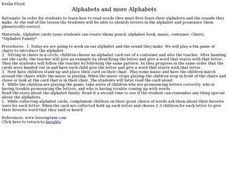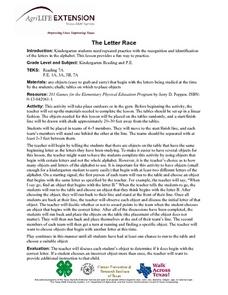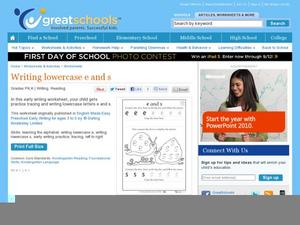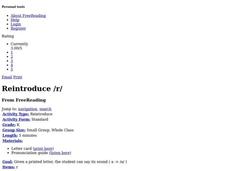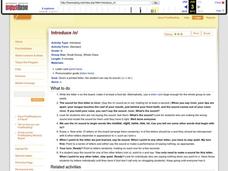Curated OER
Hello My Name is . . . Helvetica
Students play various games to help create a classroom community. In this name recognition lesson, students combine their name recognition skills with newly learned art and geometric vocabulary. First students discover vocabulary that...
Curated OER
Alphabets And More Alphabets
Students identify and phonetically pronounce the letters in the alphabet. They participate in a letter identification game, and play musical letters. Students then listen to the book "Alphabet Family" and discuss their favorite words...
Curated OER
The Letter Race
Students practice identifying the letters in the alphabet. They use this activity in phyical education class and run to each letter when they identify it correctly. They also state the name of different objects throughout the room.
Curated OER
Chicka Chicka Boom Boom
Young readers write alphabet letters. They review the alphabet and examine the relationship between letters and sounds. A final activity has each child sequence the story together.
Curated OER
O
As part of a series of alphabet worksheets, learners focus on the letters p and o. They begin by tracing the lowercase letters, using the space to print a few on their own. Next, scholars connect the letter to images that begin with the...
Curated OER
Reintroduce /x/
What words end with /x/? Unite several alphabet concepts as scholars learn all about the letter x. After identifying it, they listen to you pronounce the /x/ sound and try it themselves (use these tips to explain how you do this)....
Curated OER
Introduce /g/
As your emerging readers are learning the alphabet, set them up for success with strategies like these that incorporate multiple contexts and learning styles. Focusing on the letter g, write it clearly on the board. Model the /g/ sound,...
BBC
Lug and the Giant Stork - Capital Letters
Capital letters are the star of the show in a wonderful language arts lesson. After a teacher-led demonstration and discussion on capital letters, groups of pupils get together and work on the computer to fix the flashing letters that...
Curated OER
Writing Lowercase e and s
Get familiar with the letters e and s. Two lovely snails need your class to trace the letters on their backs. After that, they can trace and then copy each letter for good measure.
Curated OER
Introduce /f/
Hook your scholars by drawing a large f on the board; do they know what letter this is? Once you've demonstrated the sound it makes, use these tips to help them make the same sound. Although the audio function is neat, it may not be...
Curated OER
Reintroduce /t/
Use these strategies to connect letter pronunciation, sound, word examples, and recognition, focusing on the letter t. Emerging readers examine the letter and listen to you say the /t/ sound. As you explain how to do it, they try...
Curated OER
Reintroduce /r/
The /r/ sound can be a difficult one, but scholars use some helpful tips to get it right. After examining the letter shape they listen to you pronounce this phoneme and describe what you are doing to create the sound. They try on their...
Curated OER
Introduce /n/
What is this letter? Once your class is ready to explore the letter n, use these strategies to combine word examples, pronunciation, and letter recognition. First, can they identify the letter? Make the /n/ sound, explaining how you do...
Curated OER
Reintroduce /l/
Connect letter recognition, pronunciation, sound, and word examples to give scholars a solid grasp on the letter l. They watch you draw a large l on the board and make the /lll/ sound. Using your tips, they try the sound on their own....
Curated OER
Introduce /p/
Navigate the letter p without leaving anything out: combine pronunciation, recognition, letter sound, and word examples. Scholars examine the letter shape and listen to you pronounce the /p/ sound. As you explain how this sound is made,...
Curated OER
g and q
Give printing practice a creative spin as young writers become familiar with the lowercase letters g and q. They trace each letter four times before printing a set on their own in the space provided. The fun twist is that scholars use...
Curated OER
l and j
Young printers focus on lowercase letters l and j in a creative way, starting with tracing and printing each letter several times. Next, they apply these skills by tracing the letters to complete an image. These letters function as the...
Curated OER
p and b
Give your beginning printers some kid-friendly practice with the letters p and b that will ignite their artistic side. They connect the dots to trace the lowercase letters before copying them in the space provided. There are two pictures...
Curated OER
Introduce /d/
Give youngsters a better grasp of the letter d by combining letter sounds, pronunciation, recognition, and word examples. Scholars examine the letter shape then listen to you make the /d/ sound and try it on their own. Kids brainstorm...
Curated OER
Introduce /u/
As scholars are learning about letter sound correspondence use this activity to help them with the /u/ sound. Learners examine a large u on the board, identifying it if they can. They listen to you make its sound, explaining to them what...
Curated OER
Reintroduce /f/
Draw a large letter f on the board to begin this letter recognition and sounds activity, asking kids to identify it if they can. Demonstrate the /fff/ sound and explain how you are making it as learners try it out. What words can they...
Curated OER
Reintroduce /e/
These inventive strategies help emerging readers focus on the letter e, forming sound associations along with letter recognition. Explain the mouth movement in making the /eee/ sound, asking learners to try it. Can they think of words...
Curated OER
h and m
Make printing practice fun as scholars take on lowercase letters h and m in an artistic way. They connect the dots to trace the letters before copying them in the space provided. There is a scene they complete by tracing sets of each...
Curated OER
Alphabetize For A Reason
Students organize information by using the alphabet. Students organize materials alphabetically. Students alphabetize with the first, second and third letters of a set of words. Students discover applications for alphabetical order.



